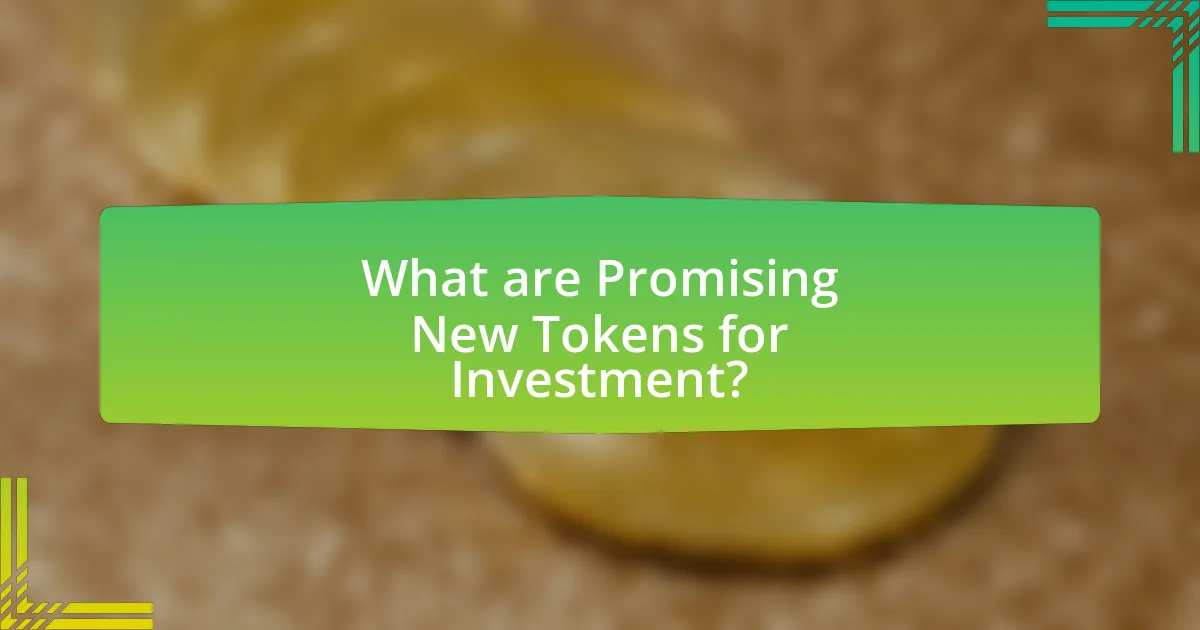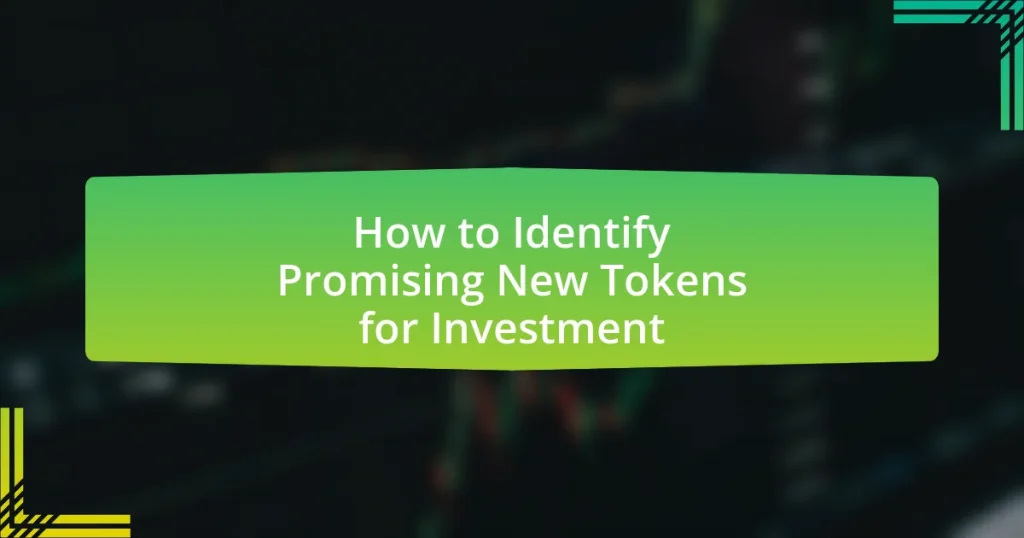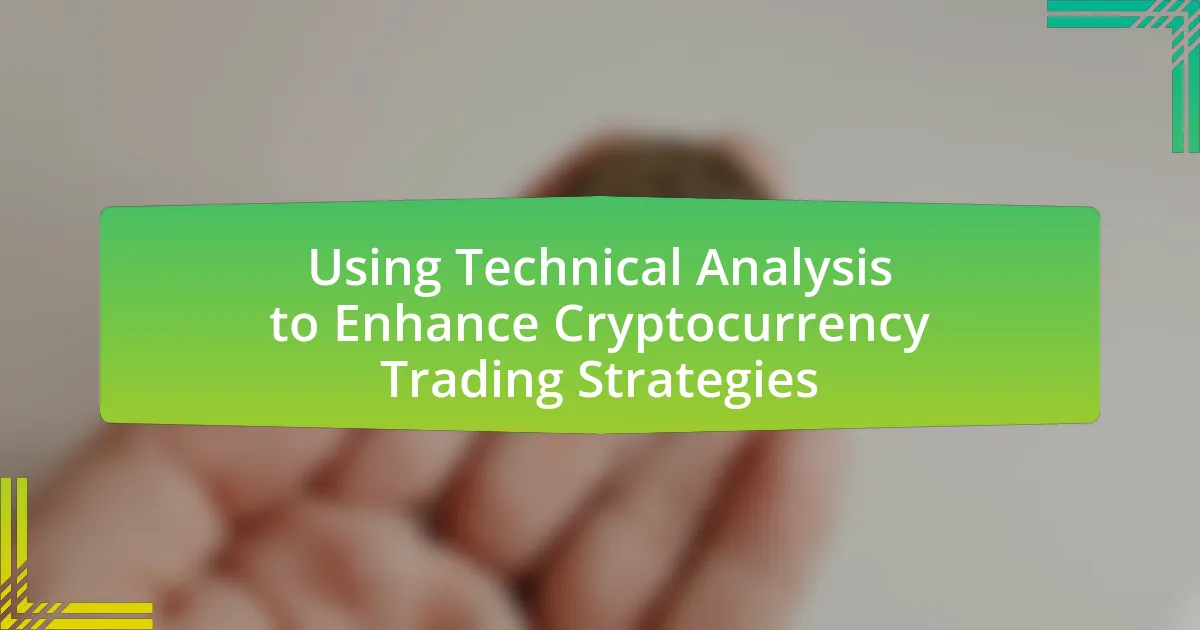The article focuses on identifying promising new tokens for investment, highlighting key examples such as Aptos (APT), Sui (SUI), and Arbitrum (ARB). It discusses the differences between new tokens and established cryptocurrencies, emphasizing factors that contribute to the potential success of new tokens, including utility, community support, and technological innovation. The article also addresses the risks associated with investing in new tokens, the importance of evaluating the development team, and the role of market trends in influencing token value. Additionally, it provides resources and best practices for investors to effectively analyze and diversify their investments in the cryptocurrency market.

What are Promising New Tokens for Investment?
Promising new tokens for investment include Aptos (APT), Sui (SUI), and Arbitrum (ARB). Aptos, launched in 2022, focuses on scalability and security, leveraging a unique consensus mechanism that enhances transaction speed and reduces costs. Sui, also introduced in 2022, aims to provide a high-performance layer-1 blockchain optimized for gaming and digital assets, attracting significant developer interest. Arbitrum, a layer-2 solution for Ethereum, enhances transaction throughput and reduces fees, making it an attractive option for decentralized applications. These tokens have shown strong market performance and community support, indicating their potential for future growth.
How do new tokens differ from established cryptocurrencies?
New tokens differ from established cryptocurrencies primarily in their market maturity and adoption levels. Established cryptocurrencies, such as Bitcoin and Ethereum, have a proven track record, significant market capitalization, and widespread acceptance, which contribute to their stability and liquidity. In contrast, new tokens often lack these attributes, resulting in higher volatility and risk. For example, as of October 2023, Bitcoin has a market cap exceeding $500 billion, while many new tokens may have market caps in the millions, indicating their nascent stage in the market. This difference in maturity affects investor confidence and the potential for long-term growth.
What factors contribute to the potential success of new tokens?
The potential success of new tokens is primarily influenced by their utility, community support, and technological innovation. Utility refers to the practical applications of the token within its ecosystem, which can drive demand; for instance, tokens that facilitate transactions or provide access to services tend to perform better. Community support is crucial, as a strong and engaged user base can enhance adoption and promote the token through word-of-mouth and social media. Technological innovation, such as unique consensus mechanisms or interoperability features, can differentiate a token from competitors and attract investor interest. Historical data shows that tokens with these attributes, like Ethereum and Chainlink, have achieved significant market success due to their robust ecosystems and active communities.
How can market trends influence the value of new tokens?
Market trends significantly influence the value of new tokens by affecting investor sentiment and demand. When positive trends, such as increased adoption of blockchain technology or favorable regulatory developments, emerge, they can lead to heightened interest and investment in new tokens, driving up their value. Conversely, negative trends, such as market downturns or security breaches, can diminish confidence, resulting in decreased demand and lower token values. Historical data shows that during bullish market phases, new tokens often experience rapid price increases, while bearish phases typically see declines, illustrating the direct correlation between market trends and token valuation.
Why is it important to identify promising new tokens?
Identifying promising new tokens is crucial for maximizing investment returns and minimizing risks. By recognizing tokens with strong fundamentals, innovative technology, or unique use cases, investors can capitalize on early-stage opportunities before they gain widespread adoption. Historical data shows that early investments in successful tokens, such as Bitcoin and Ethereum, yielded substantial returns, often exceeding 1,000% within a few years. This highlights the potential for significant financial gains when investors focus on emerging tokens with solid prospects.
What risks are associated with investing in new tokens?
Investing in new tokens carries several risks, including high volatility, lack of regulation, and potential for fraud. High volatility is common in new tokens, as their prices can fluctuate dramatically within short periods, leading to significant financial losses. The lack of regulation in the cryptocurrency market means that new tokens may not have the same protections as traditional investments, increasing the risk of scams or poorly managed projects. Additionally, many new tokens are launched without thorough vetting, making them susceptible to fraudulent schemes, which can result in total loss of investment. According to a report by the Blockchain Research Institute, approximately 80% of new tokens fail within the first year, highlighting the inherent risks associated with such investments.
How can early investment in new tokens lead to significant returns?
Early investment in new tokens can lead to significant returns due to the potential for rapid price appreciation as the project gains traction. When investors buy tokens at an early stage, they often acquire them at a lower price before the market recognizes the project’s value. For instance, historical examples like Bitcoin and Ethereum show that early adopters experienced exponential gains as these cryptocurrencies became widely accepted and adopted. In Bitcoin’s case, it rose from a few cents in 2010 to over $60,000 in 2021, illustrating the substantial returns possible from early investments. Additionally, new tokens often benefit from limited supply and increasing demand, further driving up their value as the project develops and attracts more users and investors.

What Criteria Should You Use to Evaluate New Tokens?
To evaluate new tokens, consider criteria such as the project’s whitepaper, team credentials, use case, market demand, tokenomics, community engagement, and regulatory compliance. The whitepaper provides insights into the project’s goals and technology, while the team’s background indicates their capability to execute the project. A clear use case demonstrates the token’s utility, and market demand can be assessed through existing competition and potential adoption. Tokenomics, including supply, distribution, and incentives, affects the token’s value. Community engagement reflects the project’s support and potential for growth, and regulatory compliance ensures the token adheres to legal standards, reducing investment risks. These criteria collectively help in making informed investment decisions in the cryptocurrency space.
How can you assess the team behind a new token?
To assess the team behind a new token, evaluate their experience, track record, and transparency. A strong team typically possesses relevant industry experience, demonstrated success in previous projects, and a clear vision for the token’s development. For instance, if team members have previously led successful blockchain projects or have backgrounds in finance and technology, this indicates credibility. Additionally, transparency can be gauged by the team’s willingness to share their identities, qualifications, and project roadmap publicly, as seen in projects that provide detailed whitepapers and regular updates.
What qualifications should the development team possess?
The development team should possess a combination of technical expertise, relevant experience, and strong problem-solving skills. Technical expertise includes proficiency in programming languages such as JavaScript, Python, or Solidity, which are essential for blockchain development. Relevant experience involves a track record of successfully launching and maintaining blockchain projects, as evidenced by previous work in the cryptocurrency space. Strong problem-solving skills are critical for addressing challenges that arise during development and ensuring the project’s success. Collectively, these qualifications enable the team to effectively create and manage promising new tokens for investment.
How does the team’s track record impact token credibility?
The team’s track record significantly impacts token credibility by establishing trust and demonstrating competence in the blockchain space. A history of successful projects, transparent communication, and adherence to timelines can enhance investor confidence, as seen with companies like Ethereum, where the founding team’s prior experience contributed to its widespread adoption. Conversely, a lack of relevant experience or a history of failed projects can lead to skepticism and reduced credibility, as evidenced by tokens associated with teams lacking proven expertise. Thus, the team’s past performance serves as a critical indicator of the potential success and reliability of a new token.
What role does the token’s utility play in its potential success?
The token’s utility is crucial for its potential success as it directly influences demand and adoption. A token that serves a clear purpose, such as facilitating transactions, providing access to services, or enabling governance, is more likely to attract users and investors. For instance, Ethereum’s utility as a platform for decentralized applications has driven its widespread adoption, evidenced by its market capitalization exceeding $200 billion as of October 2023. This demonstrates that tokens with defined use cases tend to perform better in the market, as they fulfill specific needs within their ecosystems.
How can you determine the real-world application of a token?
To determine the real-world application of a token, analyze its use case, utility, and the problem it aims to solve. A token’s application can often be assessed by reviewing its whitepaper, which outlines the project’s goals, technology, and intended market impact. For example, Ethereum’s token (ETH) facilitates smart contracts and decentralized applications, demonstrating its utility in the blockchain ecosystem. Additionally, examining partnerships, community engagement, and existing implementations can provide insights into the token’s practical applications and market relevance.
What are the implications of a token’s use case on its market value?
A token’s use case significantly influences its market value by determining its utility and demand within a specific ecosystem. When a token serves a clear and essential function, such as facilitating transactions, enabling access to services, or providing governance rights, it tends to attract more users and investors, thereby increasing its market value. For instance, tokens like Ethereum have seen substantial market appreciation due to their use case in enabling smart contracts and decentralized applications, which enhances their demand and perceived value. Conversely, tokens with vague or limited use cases often struggle to maintain value, as evidenced by numerous projects that failed to gain traction due to a lack of clear utility. Thus, the clarity and relevance of a token’s use case are critical factors in assessing its potential market value.

What Resources Can Help You Identify Promising New Tokens?
To identify promising new tokens, utilize resources such as cryptocurrency tracking websites, social media platforms, and blockchain analytics tools. Cryptocurrency tracking websites like CoinMarketCap and CoinGecko provide real-time data on token performance, market capitalization, and trading volume, which are essential for evaluating potential investments. Social media platforms, particularly Twitter and Reddit, offer insights from the crypto community, including discussions on upcoming projects and market sentiment. Blockchain analytics tools, such as Glassnode and Dune Analytics, allow users to analyze on-chain data, helping to assess the health and activity of new tokens. These resources collectively provide a comprehensive view of the market landscape, enabling informed investment decisions.
How can social media and community engagement inform your investment decisions?
Social media and community engagement can significantly inform investment decisions by providing real-time insights into market sentiment and trends. Platforms like Twitter and Reddit often serve as barometers for public opinion on emerging tokens, allowing investors to gauge interest and enthusiasm. For instance, a surge in discussions or positive sentiment around a specific token can indicate potential growth, as evidenced by the rise of tokens like Dogecoin, which gained traction through community-driven campaigns on social media. Additionally, community engagement metrics, such as the number of active participants in discussions or the frequency of mentions, can serve as indicators of a token’s viability and future performance.
What platforms are best for tracking community sentiment about new tokens?
The best platforms for tracking community sentiment about new tokens include Twitter, Reddit, and Telegram. Twitter provides real-time updates and discussions through hashtags and mentions, allowing users to gauge sentiment quickly. Reddit hosts dedicated cryptocurrency subreddits where community members discuss new tokens, share insights, and express opinions, making it a valuable resource for sentiment analysis. Telegram groups often serve as direct communication channels for token projects, where community sentiment can be observed through discussions and engagement levels. These platforms collectively offer a comprehensive view of community sentiment, essential for identifying promising new tokens for investment.
How can you evaluate the credibility of information shared on social media?
To evaluate the credibility of information shared on social media, verify the source of the information by checking the author’s credentials and the platform’s reputation. Credible sources typically have a history of accuracy and reliability, such as established news organizations or experts in the field. Additionally, cross-reference the information with multiple reputable sources to confirm its validity. Research shows that misinformation spreads rapidly on social media, with a study by Vosoughi, Roy, and Aral (2018) in “Science” revealing that false news stories are 70% more likely to be retweeted than true stories. This highlights the importance of critical evaluation before accepting information as credible.
What analytical tools are available for evaluating new tokens?
Analytical tools available for evaluating new tokens include blockchain explorers, token analytics platforms, and social sentiment analysis tools. Blockchain explorers, such as Etherscan, allow users to track transaction histories and token metrics, providing insights into token distribution and activity. Token analytics platforms like CoinGecko and CoinMarketCap offer comprehensive data on market capitalization, trading volume, and historical price trends, enabling investors to assess a token’s performance relative to others. Social sentiment analysis tools, such as LunarCrush, analyze social media activity and community engagement, helping investors gauge public interest and sentiment towards a token. These tools collectively provide a multifaceted approach to evaluating new tokens, enhancing informed investment decisions.
How do market analysis tools assist in identifying promising tokens?
Market analysis tools assist in identifying promising tokens by providing data-driven insights into market trends, trading volumes, and price movements. These tools analyze historical data and current market conditions to highlight tokens with strong performance indicators, such as increasing trading volumes or positive price momentum. For instance, platforms like CoinMarketCap and Glassnode offer metrics that reveal token liquidity and investor sentiment, which are crucial for assessing potential growth. By leveraging these analytics, investors can make informed decisions based on empirical evidence rather than speculation, thereby increasing the likelihood of selecting successful tokens for investment.
What metrics should you focus on when analyzing new tokens?
When analyzing new tokens, focus on metrics such as market capitalization, trading volume, liquidity, and token distribution. Market capitalization indicates the overall value of the token and helps assess its potential for growth; for instance, a higher market cap often suggests greater stability. Trading volume reflects the level of activity and interest in the token, with higher volumes typically indicating stronger demand. Liquidity measures how easily the token can be bought or sold without affecting its price, which is crucial for investors looking to enter or exit positions. Token distribution provides insights into the ownership structure, with a more decentralized distribution often signaling a healthier ecosystem and reducing the risk of manipulation. These metrics collectively help investors gauge the viability and potential success of new tokens in the market.
What are some best practices for investing in new tokens?
To invest in new tokens effectively, conduct thorough research on the project, including its whitepaper, team, and community engagement. Evaluating the project’s fundamentals, such as its use case, technology, and market demand, is crucial for informed decision-making. Historical data shows that projects with transparent roadmaps and active development teams tend to perform better; for instance, Bitcoin and Ethereum have thrived due to strong community support and clear objectives. Additionally, diversifying investments across multiple tokens can mitigate risks associated with volatility in the cryptocurrency market.
How can you diversify your investments in new tokens effectively?
To diversify investments in new tokens effectively, allocate funds across various projects and sectors within the cryptocurrency market. This strategy minimizes risk by reducing exposure to any single token’s volatility. For instance, investing in tokens from different categories such as DeFi, NFTs, and layer-2 solutions can provide a balanced portfolio. Historical data shows that diversified portfolios tend to outperform concentrated investments, as evidenced by studies indicating that diversification can reduce portfolio risk by up to 30%.
What strategies can help mitigate risks when investing in new tokens?
To mitigate risks when investing in new tokens, investors should conduct thorough due diligence, diversify their portfolio, and utilize risk management tools. Conducting due diligence involves researching the project’s whitepaper, team background, and community engagement, which helps identify potential red flags. Diversifying a portfolio across various tokens reduces the impact of a single token’s poor performance on overall investment. Utilizing risk management tools, such as stop-loss orders, can help limit losses in volatile markets. These strategies are supported by the fact that a well-researched investment approach can lead to more informed decisions, as evidenced by studies showing that informed investors tend to achieve better returns.






